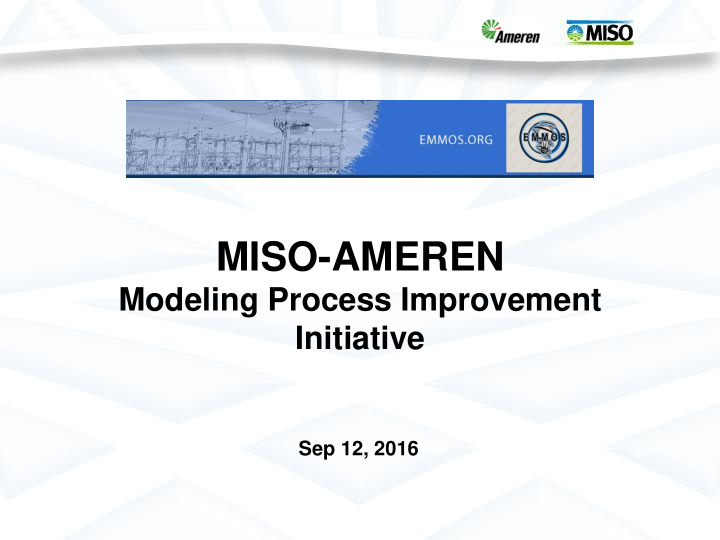



MISO-AMEREN Modeling Process Improvement Initiative Sep 12, 2016
Agenda • Industry wide challenges • Common objectives • AMEREN – Introduction – Key business drivers – Near term goals – Long term vision • MISO – Introduction – Key business drivers – Near term goals – Long term vision 2
Industry wide modeling challenges • Multiple modeling practices & Multiple Tools/Systems processes • Multiple users and maintainers EMS FTR DTS Market Planning • Models are inherently different • Duplicate efforts Internal Silos • Synchronization issues • Inconsistent solutions Technical Organizational • Difficult change management Silos at Multiple levels • ISO – EMS, Planning, Market • Utilities – EMS, Planning, Protection • Transmission, Distribution ISO/RTOs Utilities • Difficult model exchange 3
Common objectives Improved Compliance • Model accuracy & consistency • Compatible solution results Improved Efficiency • Avoid duplication • Shorter Modeling cycle • Process automation Improved Integration • Standard based data exchanges • Common and consistent APIs 4
AMEREN Modeling practices and plan
Ameren - Introduction Long-Term Total Return Outlook Diversified regional electric and gas • Expect strong ~6.5% compound annual rate base utility serving 2.4 million electric and growth from 2015 through 2020 933,000 gas customers over 64,000 • Expect 5% to 8% compound annual EPS growth square miles in Missouri and Illinois. from 2016 through 2020 2015 to 2020 Regulated 5-Yr Rate Infrastructure Rate Base Base CAGR 6.5% $16.7 20% $3.5 $12.1 11% $2.0 ($ Billions) $1.4 $1.2 6% $3.3 $2.4 2% $7.9 $7.1 2015 2020E '15-'20E 2 FERC-Regulated Transmission Ameren Illinois Gas Delivery Ameren Illinois Electric Delivery Ameren Missouri 6
Key Business Drivers View of the Future • 2.6M Customers => 10M managed resources • New solar resource goes online every 83 sec • Converged T/D/IT systems Corporate Strategy • Competition • Invest in the Grid • Aging Infrastructure • New Standards • NERC Alert Projects • Changing Generation Mix • Security = Physical & Cyber Improved Efficiency • 2010 $25M in T / 2016 $800M in T • Can’t do things the same old way 7
Near term objectives Common Language • Terminology that translates across functions (planning, operations, market, protection, maintenance, financial) and across entities Shared Commitment to Dialogue One Version of the Truth • Standards-based (CIM) databases and exchange formats • Automation (APIs) 8
Long term vision iNMM • Cloud-based • Apps (i.e. models) • OS • High Availability (i.e. 100%) - Backups • Auto-detection of new devices • Security Vertical Scalability • Systems and processes – think new devices every sec Artificial Intelligence • 95+% of display work created by AI • Validation (connectivity, ratings, etc.) • Prediction – what will the system look like next hour, tomorrow, next month, next year? Transactive Energy • DLMPs (any point where two or more customers can transact will be a market) 9
MISO Modeling practices and plan
MISO - Introduction • Generation • 175,436 MW (market) • 200,906 MW (reliability) • Load • 126,337 MW (market) • 132,893 MW (reliability) • 65,757 miles of Transmission • $20.3 billion in annual gross market charges (2013) • 400 Market Participants serving over 42 million people • EMS Model • Stations ~29000 • Network Buses ~44000 • Generating units ~6500 • Loads ~37000 • Line Segments ~42000 • SCADA points ~290000 11
Key Business Drivers Ensure Compliance • Steady-State and Dynamic System Model Validation • Improve operations and planning models accuracy and consistency • Compatible solution results across multiple functional areas Improve Stakeholder Value • Shorten modeling cycle • Process automation – Expedited and reliable process flow • Standardize model data submission and exchange Capitalize on Technological Advancements • Planning moving towards node-breaker model • Coordinated data model formats • Distributed Energy Resources • Standard based common and consistent APIs 12
Near term objectives • Engage model dependent upstream and downstream systems for process requirements and timing to reduce cycle time Process review • Engage Stakeholder community on model building process and timing Stakeholder Outreach • Engage Neighboring RC community on data exchange timing and requirements Industry Engagement • Standardize Model Exchange format Standardize Input 13
Long term vision Current State Desired State External Entity Needs External Entity Needs Inputs integrated Customer Customer across all models Various data Inputs Inputs formats Standardized TO 1 Planning Planning TO 1 Input Format Bus Branch Studies TO 2 TO 2 TO n Centralized TO n Network Operations Model Manual Apps Node Breaker Collection and Management MP 1 MP 1 Translation MP 2 MP 2 Markets Market MP n Asset Apps MP n Standardized Automated Ownership Translation Validation Inadequate integration across Planning, 14 Operations, and Markets
Thank you
Recommend
More recommend